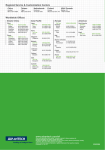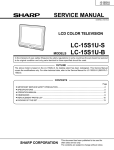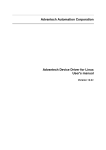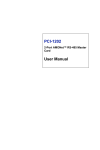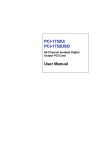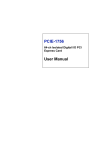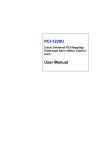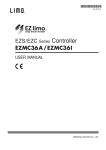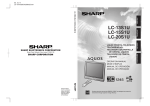Download Advantech PCI-1241 Specifications
Transcript
Motion Control Application Stories Versatile Form Factors to Meet Diverse Applications Flat Panel Display Production Semiconductor Production SMT/PCB Industrial Assembly Electronics Assembly www.advantech.com/eA The market for electronics manufacturing is among the biggest in the world, and more and more of the production is now being outsourced to facilities in the fast-growing economies of Asia. At the same time, new technologies are being implemented to minimize inventory, improve quality, and cut design time to launch products faster than ever before. The outsourcing model of manufacturing has often improved economies of scale, but has also highlighted the importance of a wholistic approach to making products. Manufacturing needs to be seamlessly integrated with areas that earlier were considered to be different from manufacturing. • To reduce inventory, the manufacturing of parts needs to be linked to the demand for these parts in the factories that need them for assembly of systems. • Integration of processes related to design, manufacturing, and quality control engineers helps improve quality control. Flat Panel Display Production • Design cycle times are being reduced so that manufacturing teams can achieve volume production as soon as possible, and make their products reach the market before anyone else. Today, hundreds of factories all over the world are seeing their inventories shrink, and their product development cycle being shortened; thanks to equipment based on Advantech technologies and system integrator expertise. SMT/PCB Industrial Assembly 1 Table of Contents Flat Panel Display Production 1 2 3 4 LCD Panel Loader/ Unloader Korea P. 5 TFT Defect Inspection in LCD Panel Assembly Taiwan P. 7 TFT Defect Repair in LCD Panel Assembly Taiwan P. 9 TFT Light Testing in LCD Panel Assembly Korea P. 11 Semiconductor Production 5 6 7 8 Electronics Assembly Automated Programmer for ICs Malaysia P. 13 RAM Module Compatibility Test China P. 15 Laser Marking for Microchips Taiwan P. 17 Solder Placement System for BGA/CSP Chipsets Taiwan P. 19 SMT/PCB Industrial Assembly 9 10 11 12 Semi-Automatic PCB Separator China P. 21 SMT/PCB Line Mounter Taiwan P. 23 Auto-Optical Solder Inspection Taiwan P. 27 Automatic Solder Dispenser Malaysia P. 29 Electronics Assembly Semiconductor Production 13 Quality Control of Frequencies for Mobile Phones 14 15 Keypad Quality Control for Mobile Phones China P. 33 High-Precision Motion Control for 3D Laser Engraving China P. 35 16 Tube Bending Machine Taiwan P. 37 Taiwan P. 31 2 Complete Application-Ready Platforms for the General Advantech offers application-ready platforms that range from industrial workstations and industrial-grade CPUs, to motion control, encoder input and isolated I/O cards for general motion control (GMC) application such as SMT/PCB, semicondutor and LCD manufacturing machines. As machine automation develops, high speed, effective distance transmissions, and convenient wiring become increasingly important for system integrators. Advantech Distributed Motion Control (AMONet) is a series of products with innovative architecture that is designed for versatile industrial automation application, and are especially suitable for distributed motion control requirements. Motion Control Configuration Distributed Motion Control Centralized Motion Control ADAM-3212/JS2 PCI-1247 100M PCI-1240 Mitsubishi Mitsubishi ADAM-3211/PMA ADAM-3956 Panasonic Panasonic Indicator & Sensor Handwheel & Jog Indicator & Sensor What is the difference between centralized and distributed motion control ? Machine control system architectures generally fall into two categories - centralized or distributed. In a centralized system, all control loops including logic, trajectory generation, and PID control, are executed on a single processor on a programmable automation controller (PAC). In a distributed system, the trajectory generation and logic control executes in the central processor, but the PID control loop is executed in the intelligent slave module. A distributed approach gives more processing power, while it reduces overall wiring cost and system complexity. Centralized Motion Control The Distributed Motion Control Products are categorized in two groups - Master Cards and Slave Modules. Communication between master and slave is based on a custom-engineered technology based on RS-485, which saves wires, transmits over long distances at high speeds, and have time-deterministic features. The communication interface between master and host PC is based on memory mapping. Various functions can be chosen on the slave modules, and the industrial DIN-rail mountable design makes it easy to distribute them in the field. The master card collects information from slave modules and publishes the data to its host PC, and vice versa. 3 Sensors and Actuators Sensors and Actuators Sensors and Actuators Motion Control Market Voltage-command Motion Control Embedded Motion Control PCI-1241 PCM-3240 UNO-2170 Mitsubishi Mitsubishi Panasonic Panasonic Indicator & Sensor Handwheel & Jog Indicator & Sensor Distributed Motion Control Master 100M Slave Sensors and Actuators Motion Control Cards Sensors and Actuators Slave Sensors and Actuators Slave Sensors and Actuators Slave Sensors and Actuators 4 1 LCD Panel Loader/Unloader Flat Panel Display Production Korea Introduction Project Requirements LCD screens have replaced CRT’s as the preferable choice for computer monitors, and increasingly, TV’s as well. Therefore, LCD production is currently one of the fastest growing product categories in the consumer electronics market, and rapid growth is expected for many years to come. Due to rapid technology development and competitive pressure, an LCD manufacturer in Taiwan switched from a proprietary to a PC-based control system to track production and utilization information in real-time. This new motion integration control system not only reduces standby time, but also decreases data acquisition time to improve quality control. Proprietary control is a very cumbersome technology. It not only operates under an unpopular and sophisticated programming language, but it also consumes a large amount of time for control changes. Furthermore, the price of maintaining proprietary control is quite expensive compared to PC-based control. These lead to inefficient and expensive manufacturing processes. In order to set up a flexible and PC-based motion control system, the following components are required: •High-speed motion control card to accurately control the robotic arm as it moves LCD panels between storage and processing •Slave module with digital inputs to capture information from sensors that detect the position of the panels on the conveyor belt 5 Solution Description Conclusion The system has a robotic arm to load or unload the panels from the stack, and conveyers to move panels through the belt. On top of the conveying processes, there are sensors set up for panel alignment. Finally, the panels are placed to the designated machines or into storage with another robotic arm. In the traditional way, a proprietary system is used to control the robotic arm and a PC-based controller is used to integrate the product information with MES (Manufacturing Execution System). However, this requires manpower and is very time-consuming. With the implementation of PC-based AMONet solution, PCI-1202 and ADAM modules, many inefficient areas of the process can be mitigated. The system will have less standby time, higher performance, a lower error rate, and is much more cost-effective. The user can have real-time processing updates and flexibility in modification. Advantech’s AMONet solution also provides the following benefits: •Suitable for both standalone and automated systems •SEMI protocol compliant The operation information can be integrated into the MES (Manufacturing Execution System) or CIM (Computer Integrated Manufacturing) System. The alternate and new solution our customer adopted is Advantech’s PC-based AMONet module, the PCI1202; which provides 20MHz of data transfer speed (updating 1024 Digital I/O channels within 1.04ms) and is capable of fulfilling high-speed control requirements. The PCI-1202 can control and update both robotic arms and the conveyor through the high-speed serial communications. Each robotic and sensor station uses Advantech’s ADAM-3752FN/ 3754FN/3756FNN series. Each ADAM acts as a medium between mechanical stations and a master control, and also provides accurate alignment of the glass and error control. Digital Input/Output ADAM-3752FN 32DI Sensor ADAM-3754FN 32DO Conveyor ADAM-3756FNN 16DI/16DO Robot ADAM-3756FNN 16DI/16DO PCI-1202 2-port AMONet™ RS-485 Master Card Robot 6 2 TFT Defect Inspection in LCD Panel Assembly Flat Panel Display Production Taiwan Introduction Project Requirements During the LCD manufacturing process, having a zero fault tolerance is almost impossible. Moreover, LCD panels are very delicate products, and can frequently have minor defects. Therefore, defect inspection is essential at each assembly station. Our customer wanted to increase the efficiency of their defect inspection stations and speed up their overall LCD production. They were using the traditional method of inspection, which consisted of having just one camera to complete the process, which is slow and cumbersome. With a new PC-based automation solution from Advantech, more cameras can be set up for inspections, allowing a smoother and faster production flow. Defect inspection is an extremely important part of the production process. It prevents a vicious cycle by not allowing defects to continue further along the manufacturing process. With the implementation of more than one camera, increased processing speed and network expansion are necessary. In order to efficiently inspect each large LCD panel, using a PC-based operating system is the optimal way. Furthermore, it allows data communication between the database and each station. To formulate such a system, we need the following components to complete our automated solution: •A master control card for handling all the commands and data flow •A motion control card for all the camera orientations •An isolated Digital I/O card for the command and handshakes between stations 7 Solution Description Conclusion Each camera at the inspection station takes photos of different segments of each LCD panel. The processed picture will be compared to reference pictures for examination. Even though the idea of having more cameras seems obvious, it is limited by the hardware and software capabilities. In the old proprietary system, the non user-friendly programming language and poor compatibility impeded the manufacturing resources. Defect inspection can be a hassle if resources and expansion abilities are limited. With the automated solution provided by Advantech, more cameras can be set-up, increasing the defect inspection efficiency, and streamlining the entire LCD panel assembly process. Furthermore, it will provide real-time updates and monitoring, effectively upgrading quality control. With Advantech’s automation solution, more cameras can be implemented due to the large expansion capabilities, and more motions and commands can be installed. PCI-1202 is a master control card which can be implemented in the PC to process all the motion instructions and data communications. As for the inspection station, ADAM-3212/J2S can be used for camera or conveyor motions and ADAM-3752/3754 can be used for sensors to ensure the inspection has operated thoroughly. Moreover, Advantech’s AMONet has built-in CPU for each module and allows Ethernet communication between stations. This provides a real-time updates and monitoring. Digital Input/Output and Motion Control ADAM-3752FN 32DI Conveyor ADAM-3754FN 32DO Conveyor ADAM-3212/J2S 1-axis AMONet® RS-485 Slave Module Robot ADAM-3212/J2S 1-axis AMONet® RS-485 Slave Module PCI-1202 2-port AMONet™ RS-485 Master Card Robot 8 3 TFT Defect Repair in LCD Panel Assembly Flat Panel Display Production Taiwan Introduction Project Requirements LCD Panels can have defects that need to be repaired during the panel assembly process. Spending resources to find problems, but not being able to solve them in the most efficient way degrades the flow of the entire process. LCD panels have infinitesimal arrays and cells embedded in the panels, and require a precise laser to fix the minor defects in the pixels. Therefore, it is critical to have a flexible and fast repairing system that will efficiently fix problems and at the same time not impede the overall flow. To be successful, manufacturers have to balance the need for consumer demand, resources and competition. Although balancing these factors can be difficult, the key is to focus on managing day to day production. The most efficient method to manage production is a PC-based distributed motion control system. It allows for an open architecture with excellent expansion capabilities and high compatibility. To formulate such a system, we need the following components: •A master control card for handling all the commands and data flow •A motion control card for the laser positions and orientations •An isolated digital I/O card for the command and handshakes between stations 9 Solution Description Conclusion The repairing system is designed to identify each of the damaged pixels and have the coordinates sent to the mechanical laser arm. Then, the laser will burn the right spot for damage control. The whole process may seem very simple; however, the data acquisition and information flow are extremely complex. The coordinates may vary from 2D to 3D, and the commands for the mechanical arm have to be extremely accurate due to the size of each array on the panel. With Advantech’s machine automation solution, the master card PCI-1202 can handle different sets of complicated instructions. The motion control module ADAM-3212/J2S is capable of varieties of motion controls that allow different laser orientations. For the data flow, the Digital I/O card ADAM-3752/3754 has up to 64 inputs and outputs. More controls and data communication are feasible. At last, a PC-based system can provide a real-time manufacturing status and keep in track of the utilization rate at each station. Therefore, the maintenance allows operations at the maximum efficient level, and the system can stay in the best shape. During the manufacturing process, it is inevitable to have defects in the products. Having a flexible and efficient repairing system will not only maximize the whole production quantity but also enhance the quality standard. With Advantech’s PC-based machine automation solution, all the limitations provided by the old proprietary system should not be a problem anymore. The new repairing system can meet up with the production flow and increase the overall quality control. Digital Input/Output and Motion Control ADAM-3752FN 32DI Conveyor ADAM-3754FN 32DO Conveyor ADAM-3212/J2S 1-axis AMONet® RS-485 Slave Module Robot ADAM-3212/J2S 1-axis AMONet® RS-485 Slave Module PCI-1202 2-port AMONet™ RS-485 Master Card Robot 10 4 TFT Light Testing in LCD Panel Assembly Flat Panel Display Production Korea Introduction Project Requirements Some manufacturing industries focus on mass production, while others focus on the quality of the product being created. In the growing LCD market, both quality and quantity are in high demand. An Advantech customer in the LCD market wanted to increase the quality control of their LCD inspection process, and decided to focus on the lighting inspections for their TFT panels. In such a demanding manufacturing environment, upgrading to a flexible PC-based machine was the only option. LCD panels are very delicate products; during the assembly process the panels have to be treated with great care. An efficient light tester is used to confirm correct assembly of the panel, including the raw panel with driver ICs and the backlight unit. Furthermore, position adjustments and function tests require great accuracy and speed. In order to achieve these goals, the following components were required: •A motion control card responsible for moving the panels along a conveyor •An isolated digital I/O card responsible for sensors, push buttons, and the handshake signals between stations •Master control card for handling all the commands 11 Solution Description Conclusion Due to the complexity of the LCD manufacturing process, orientation and spacing are extremely critical. With Advantech’s PCI-1202 and ADAM3752FN/3754FN modules, sensors make sure all the panels are in the right order and correct position on the conveyor. All the push buttons are also integrated within this system. Furthermore, the handshake signal between this station and other stations (such as in-between material handling and unloading) ensures good traffic control. For the panels to be accurately mounted into the inverter for software testing, Advantech’s ADAM-3212/J2S motion control card will control the mechanical tilting device and ensure the connectors are fastened to the inverter for the benchmark lighting test. The panels will then be tilted for engineers due to the limitations on the viewing angles for lighting quality examination. Once the panel has passed the test, it will travel to the next station. LCD production is a very time-consuming and precise process. The traditional way of using proprietary systems lowers efficiency, is inflexible, increases costs and is difficult to maintain. Also it is not easy to integrate the production and utilization information of this station into a CIM/MES system. With a PC-based testing machine, the process is now much more cost-effective, and defect rates have been decreased. Moreover, the overall efficiency of the entire process has been increased. Digital Input/Output ADAM-3752FN 32DI Sensor ADAM-3754FN 32DO ADAM-3212/J2S 1-axis AMONet® RS-485 Slave Module ADAM-3212/J2S 1-axis AMONet® RS-485 Slave Module Robot Robot PCI-1202 2-port AMONet™ RS-485 Master Card Sensor 12 5 Automated Programmer for ICs Semiconductor Production Malaysia Introduction Project Requirements A handheld electronics manufacturer faced the risk of not meeting customer demands when their assembly process slowed to a crawl. They wanted to run their machine vision simultaneously with motion control to save time, but the performance of their system became sluggish due to the large memory requirements of the vision software. Our customer needed a major upgrade to their assembly system, and wanted an automated system with real-time monitoring. Our customer wanted the system to operate a variety of input and output options with tray, tube and tape thus providing programming, marking and packing conversions for most IC products on/in tray, tube and tape. In order to fully maximize the speed and accuracy, machine vision is required to perform tasks with the robotic arm simultaneously, which requires a huge CPU memory cache. It became evident that an integrated PC-based system was required to allow high-performance automated control running in the conjunction with the machine vision software. To achieve such a system, the following components were required: •A master card controlling all the motions and data processing •A control card commanding actions of each station 13 Solution Description Conclusion The automatic pick and place operation runs in the sequence of loading, position, marking, targeting programming, sorting and unloading. These steps can be time consuming, and a heavy duty motion control card is required to accomplish such tasks. Accuracy and speed are key elements for pick & place programming tools. The variety of motion control and the large data flow can cause huge traffic in the assembly process. With Advantech’s motion control PCI-1240U cards, intelligent, accurate operation and high throughput can easily be achieved. Moreover, by implementing Advantech solutions, the pick and place tools are now much more accurate and efficient, and the entire process is now automated with real-time motion control. Advantech’s PCI-1240U, the master control card, supports these accurate and fast motion controls. Its onboard ASIC incorporates a variety of motion control functions which can be performed without any processing jams. Moreover, it allows a major upgrade from single manual to dual auto/semiauto. Additionally, large data flow and programming control will not be issues anymore. Moreover, the two precise CCD cameras equipped within the robotics arms for IC targeting and socket or pick & place spot positioning can both be operated under the command efficiently and swiftly. Even though the mechanical and optical operations can be extremely complex, PCI-1240U can allow both operations to work simultaneously. With Advantech’s PCI-1756, all the push buttons, indicator bulbs and the light tower are well integrated. Moreover, the PCI-1756 provides the handshake signals with the tray and tube devices. PCI-1756 64-ch Isolated Digital Output Card Digital Input/Output Motion Control Switch, Button and Indicator PCI-1240U 4-axis Universal PCI Stepping/ Pulse-type Servo Motor Control Card Nozzle Mechanism 14 6 RAM Module Compatibility Test Semiconductor Production China Introduction Project Requirements To improve test speed and accelerate changes in their production line, a large RAM module manufacturer chose to switch from PLC to PC-based machinery for compatibility testing. The new system, designed with Advantech’s PCI-1240U, and PCI-1750, completely integrates motion control and data acquisition, dramatically reducing standby time and increasing output. The customer’s system used proprietary system for motion control, which were difficult to operate with the PC-based RAM modules and motherboards used for testing. The basic requirement therefore, was to simply implement a PC-based system. Additionally, the system should have the ability to allow one tray of RAM modules to be tested while the second tray is being loaded. Not only would this allow for more efficient operation, but also double the testing speed while only requiring one operator. Solution Description The system is designed to test compatibility with RAM modules in common motherboards. For this application, two trays of RAM modules are prepared and a pick-and-place tool moves the modules into a motherboard for the compatibility test. After the test, the modules are placed on an output tray. 15 The process starts with loading the dimensions, pin assignments, profile, and batch number into the system computer. A tray of RAM modules is then placed in the machine, and the operator presses a button to start the test. Conclusion •The new system is entirely based on industrial PCs, meaning maintenance and operation has been considerably simplified •The PC-based system provides a larger memory and an open architecture that is easier for PCI-1750 starts by using a digital input for a sensor that detects the presence of the RAM module tray. If present, digital output channels are used to turn on the activation light and inform PCI-1240U that it is time to start moving the modules. PCI-1240U responds by using three of its axes to pick the first module from the tray and place it into the fixed motherboard. When placed, PCI-1750 uses a digital output to turn on the power of the motherboard. programming and expansion Software running on the machine’s computer fills the memory of the RAM module with a pattern, which is then read back and checked to see if anything had changed. If not, the module has passed the test and is placed in an output tray leading to the packaging machine. If there is an error, the module is moved to a tray for defect modules. No matter what the result is, the system records the test result in a database over an Ethernet connection, together with the serial number of the RAM module. The test continues with the pick-and-place tool moving to the next RAM module on the tray until all are tested. While one tray is being tested, the operator prepares the second tray. PCI-1750 32-ch Isolated Digital I/O and Counter Card Digital Input/Output Motion Control Switch, Button and Indicator PCI-1240U 4-axis Universal PCI Stepping/Pulse-type Servo Motor Control Card Pick & Place Mechanism 16 7 Laser Marking for Microchips Semiconductor Production Taiwan Introduction Project Requirements: One of the final steps in the production of microchips is the printing of the information on the chip itself. Most chips just have a batch number and logo, but there is a new trend to include more information and have more complex patterns printed on the chips as well. When the pattern to print on a microchip becomes more than just a few dots, transferring it to a PLC through a decoding program can become troublesome. Logos and patterns are often created in AutoCAD, Pro/E and other PC-based applications. Using a PC over a PLC allows operators to load these patterns directly into the machine instead of having to go through an additional decoding process. This results in a faster turnaround and the capability to have more complex designs. A customer used Advantech’s PCI-1761, PCI-1240U, FPM-3120 and ACP-4001 with a machine vision system to create a fully automatic laser marker for microchips. By using PC-based products, their new system is more powerful, more versatile, and can easily adapt to changes in the market. To fully automate this system, machine vision is necessary. And for high quality machine vision, the captured images are so large that only a computer can process them. It was fairly obvious that if the whole system was PC-based, system integration would become easier. The requirement was therefore to get a PC-based system to replace the customer’s low-performance PLC-based system. 17 Solution Description: The machine loads a pattern file into its memory and calibrates the machine vision software so that it knows where to print on the microchip, and where to check the finished markings. Microchips are brought to the machine in a continuous stream on a conveyor belt. One axis of the PCI-1240U is used to control the speed of the conveyor belt, which can help ensure there is coordination with other machines in the production line. When a microchip has entered the machine, a door closes, and the digital output of PCI-1240U turns on a warning indicator. A sensor detects if the door is closed properly and sends a signal to the PCI-1761. Another image is captured of the microchip, this time to verify that the marking has been successful. If not, this will set off an alarm, and a copy of the image will be stored on the system for troubleshooting. If successful, PCI-1240U turns off the warning indicator, and activates the 4th axis to start the conveyor belt that brings the microchip out of the machine. Conclusion: •Fully automatic system removes the need for operators •Faster processing for intricate or large patterns compared to proprietary systems •No need to decode programs between the computer and proprietary systems •Reduced support costs as system can be remotely diagnosed. By using software like PC- Anywhere or NetMeeting to check the machine over the Internet, the need to visit field sites can often be eliminated. For this customer, it meant saving several international trips every year. When the PCI-1761 receives the signal that the door is closed, it will initialize the frame grabber card. The frame grabber card captures an image of the microchip, and the machine vision software analyzes the image and determines the orientation and exact position of the microchip. It also sets the reference point for the X and Y axes. With the reference point now set, the two axes of the PCI-1240U can be used to direct the laser beam over the surface. Digital output signals from PCI-1240U are used to switch the laser on and off during the marking. Circular and linear interpolation enables intricate patterns. On completion, the laser is moved back to its secure position. PCI-1761 8-ch Relay Actuator and 8-ch Isolated Digital Input PCI Card Digital Input/Output Motion Control Switch, Button and Indicator PCI-1240U 4-axis Universal PCI Stepping/ Pulse-type Servo Motor Control Card Laser Marking for Microchips 18 8 Solder Placement System for BGA/CSP Chipsets Semiconductor Production Taiwan Introduction Project Requirements The soldering process is a critical stage in the circuit assembly process, as any faults can cause severe damage to the device. Furthermore, technology improvements and higher consumer demand for electronic products have forced circuits to evolve smaller and smaller. At the same time, the need for mass production is inevitable; therefore, having a fast and highly precise soldering machine is extremely important. With a PC-based solution, both the demand for mass production and need to keep pace with technology trends can be met. In a traditional PLC-based system, programming sophistication and poor data acquisition have limited efficiency and quality control. Especially for soldering BGA or CSP chipsets, the solder placement system requires high quality control and low tolerance for errors. The newly introduced PC-based solution has flexible control and real-time monitoring, and also allows a fully automated operation. In order to achieve such performance, the following components are required: •A PC-based industrial computer for central processing with high-speed performance •Highly precise soldering process for small components 19 Solution Description Conclusion The concept of a proprietary solder placement system is to have a central computer compiling all the data and to provide real time monitoring for the users. Advantech’s UNO-2160 is a compact and fanless computing platform with two PC/104 slots allowing high expansion abilities. It has no moving parts and excellent vibration resistance. Usually older compact computing platforms are designed as proprietary systems, which create bottlenecks when connecting to MES system from isolated to integrated automations. Therefore, UNO-2160 will not only allow higher flexibilities, but also generate larger data processing abilities. With the combination of Advantech’s UNO-2160 and PCM-3240, having a highly precise and reliable solder ball placement system is made possible. In terms of users’ point of views, real-time monitoring and data storage allow higher quality control. On the other hand, anti-vibration and a large number of I/O channels decrease the errors and increase the expansion capabilities for the future. There are also few more benefits using these two Advantech products. •SEMI protocol compliant •Data could be integrated into the MES (Manufacture Execution System) or CIM (Computer Integrated Manufacturing ) system, with a Windows-like GUI for easy operation The role of an embedded motion control card is to accurately control the solder printer. The printing precision and motion are very critical in the soldering process. They do not allow any movements that will cause inaccuracies. Therefore, we recommended Advantech’s PCM-3240 for this solution. It can provide 4-axis pulse-type servo or stepping motor control, and moreover, its compact size can be fitted inside the chassis of an UNO-2160, yet provide the same functions as a standard industrial computer and plug-in motion control card. PCM-3240 has 12 channels of digital input and 16 channels of digital output which allow high bits for highly precise motor and sensor controls. Digital Input/Output PCM-3240 4-axis Stepping/Pulse Servo Motor Control Card Motion Control Sensor Switch and Button Solder Paste Printer Mechanism 20 9 Semi-Automatic PCB Separator SMT/PCB Industrial Assembly China Introduction After many tough years, the PCB industry has learned that survival relies on investing in new equipment and technology. Chief among the new PCB markets is mobile communications, where handsets need highly compact and flexibly shaped PCBs. To meet this demand, a machine builder in China used Advantech chassis, I/O and motion control products to create a new general-purpose PCB separator. The new machine offers high precision, and allowed separation of complex PCB shapes. Project Requirements •To deal with the demand for smaller PCBs, the system had to be very precise. •PCBs for handsets required rounded and irregular edges. •Integration with machine vision software needed to be easy and simple. Solution Description A PCB separator is used to cut PCB boards into separate circuits. By keeping several identical circuits on the same physical board during component placement, the pick-and-place tools do not have to be changed out so often. This speeds up component placement, which usually is the bottleneck of a PCB production line. The system starts with the operator placing a fixture filled with PCB boards into the machine. When the fixture is in place, the operator presses a button to activate the PCB separator. PCI-1750 captures the button signal with an input channel and uses an output channel to move the fixture to the separation area. A sensor confirms that the fixture is in place by sending a signal to an input channel on PCI1750. This unlocks the secured laser cutter, turns on the warning light, and initiates the machine vision software. 21 For more precise separation, machine vision software is used to set the cutting coordinates. A picture is taken of the PCB and cutting coordinates are calculated and sent by the machine vision software to the PCI-1240U motion control card. The laser starts cutting the PCB, using PCI-1240U’s interpolation features for the rounded and irregular shapes. PCI-1750 is used for on/off control of the laser beam. At completion, the laser is secured, the warning light is switched off, and the fixture moves out from the separation area while a second fixture moves simultaneously into the separation area. The operator picks up the fixture with complete PCBs and replaces it with a new one. Conclusion •The use of PCI-1240U together with machine vision software has resulted in a PCB separator with cutting precision of ±0.01 mm. •The interpolation features of PCI-1240U made it unproblematic to perform cutting of rounded and irregular PCB shapes. •With a PC-based system, integration with machine vision software was quick and easy •The customer was so pleased with the semi-automatic PCB separator that another fullyautomatic model has since been designed with Advantech products. Product Implementation •PCI-1240U is a 4-axis universal PCI stepping/ pulse-type servo motor control card, and was used to control the laser movement in this application. •PCI-1750 is a 32-ch isolated digital I/O and counter card, used for simple fixture movement, sensor input signals, operator interface communications, and on/off control for the laser. •Both cards are placed in an IPC-644 4-slot MicroBox Desktop/Wallmount Chassis for compact and protected storage. PCI-1750 32-ch Isolated Digital I/O and Counter Card Digital Input/Output Motion Control Switch, Button and Indicator Miller Mechanism PCI-1240U 4-axis Universal PCI Stepping/ Pulse-type Servo Motor Control Card 22 10 SMT/PCB Line Mounter SMT/PCB Industrial Assembly Taiwan Introduction Project Requirements In the electronics industry, mass production has become a necessity for any manufacturer who hopes to succeed. To keep pace with market demands, the traditional methods of manual labor have become obsolete; so much so that no company can survive without the help of an automated solution. PC-based pick & place machines can quickly and accurately place the right component to the right place, with live updates. Our customer wished to upgrade to an automated pick & place machine to increase their production and streamline their manufacturing process. In the manufacturing process for PCB boards, complexity and preciseness are extremely critical. With a PC-based automated pick & place machine, the entire manufacturing process is much more cost effective. Furthermore, it increases high-density interconnect (HDI) and high layer count (HLC). In order to formulate such a machine, the following control components are required: •A central control card to manage motion and data processing •A motion control card to command the movements of the mechanical station 23 Solution Description Conclusion One of the current implementations uses a PLC to control the nozzle, and a PC-based controller to integrate product information to MES. However, this is not very efficient; the need to maintain two different technologies is cumbersome and time consuming. The newly proposed solution with a plug-in motion control card integrates nozzle control and production information to MES in one system, and can be made possible with Advantech’s PCI1240U. PCI-1240U provides 4-axis stepping and pulse-type motion control. Moreover, the onboard intelligent motion ASIC builds in a variety of motion control functions such as 2/3-axis linear interpolation, circuit interpolation, T/S-curve acceleration and deceleration. These functions can be performed without processor loading during operation. Keeping pace with new technology trends is always difficult. With a PC-based pick-and-place machine, however, our customer will have luxury of expansion capabilities, and increase their overall efficiency. The goal of staying on top of the high manufacturing status can be fulfilled. •High speed placement of smaller SMT components •Low loss ratio improving placement reliability •Using a PC-based system to reduce the system cost and easy to expand •PC-based architecture can be integrated with MES to achieve low loss ratio, improving placement reliability. Another important process in the automation solution is quality control. There should be sensors checking the quality and accuracy of each PCB board. Advantech’s PCI-1756 provides 32 isolated digital inputs and 32 isolated digital outputs with channelfreeze functionality. It allows reset protection function which enables the default configuration in the event of an incorrect operation during an unexpected system reset. The final product quality can be easily ensured, and overall, the performance level can be raised significantly. . Digital Input/Output PCI-1756 64-ch Isolated Digital I/O Card Motion Control Nozzle Mechanism Switch and Button PCI-1240U 4-axis Universal PCI Stepping/ Pulse-type Servo Motor Control Card Sensor 24 11 Auto-Optical Solder Inspection SMT/PCB Industrial Assembly Taiwan Introduction Project Requirements Printed Circuit Boards are used in virtually every electronic device today, from cellular phones and personal computers to industrial and medical machinery. One of the most integral steps in assembling Circuit Boards is the solder placement. Our customer was using an outdated system that required 2 expensive machines, one for machine vision and one for machine control. Furthermore, this system was only capable of 2D solder inspection, which is not good at judging the corners/angles of the placement and can cause weak connections, leading to faulty boards and potential short-circuits. They desired to have an entirely new system, with the following requirements: Our customer was having issues in the creation of their Circuit Boards with misplaced and weak solder joints. Furthermore, they were using 2 separate machines for 2D solder inspection. To save costs, increase reliability, and speed up the inspection process, the customer wanted only 1 machine that could handle machine vision and control with 3D solder inspection capabilities. •They wanted 1 machine that could handle both machine vision and control •The system needed to have 3D solder inspection capabilities •They wanted a higher-performance PC-based system •The system needed to have high inspection accuracy with high-speed motion control •They wanted a system that required less management Solution Description The system is comprised of an Optical Inspection machine which examines the surface of the PCB board. In the machine architecture, there are 2 subsystems, one for moving the PCB board and the other for visual quality 25 inspection. These systems work independently within the machine providing a combined solution. In this application, the motion “trajectories” are sent from the host to the drives. The drives interpret the trajectories and drive the servo motors accordingly. The drives also run supervisory monitoring programs and can execute a programmed script that is stored in flash memory. Previously, a centralized controller with a PC frontend was used to interface with I/O pneumatics and the motion system. This put the burden of the machine control on a single processing system in which all devices received commands and reported back data (feedback position, sensor state, etc.). Advantech’s PCI-1240U was applied for the highspeed motion control, giving the added performance from motors. For the I/O card architecture, Advantech’s PCI-1751U DI/O card is applied, helping the moving motor control different lighting for visual judgment, which helps make the inspection clear and reliable. Conclusion By combining Advantech’s PCI-1240U and PCI-1751U cards, a high-performance, highly reliable, and cost-effective solution was found. The customer now had 1 machine that controlled machine vision and motion control, with 3D solder inspection capabilities. Furthermore, the system provided the following benefits: •3D solder paste printing inspection machine •Ultra simple and highly precise in-line PCB inspection system •Ultra high-speed inspection •Real-time judgments of failed patterns •High-speed and easy Human Machine Interface •SPC (Statistical Process Control) System providing Online fault Pareto listing The main purpose of an SPC (Statistical Process Control) System is to collect quality-related data during production process for further statistical analysis, and to discover any abnormality in the production process. Having two subsystems running independently (automatic soldering application and automatic visual inspection) with the ability to interact with each other for coordinated motion, allowed the overall machine to provide 20% more throughput. This, coupled with a quicker changeover process, provided greater machine utilization when smaller production runs dictated machine usage. PCI-1751U 48-bit Universal Digital I/O and Counter Card Digital Input/Output Motion Control Switch, Button and Indicator Optical Inspection Mechanism PCI-1240U 4-axis Universal PCI Stepping/ Pulse-type Servo Motor Control Card 26 12 Automatic Solder Dispenser SMT/PCB Industrial Assembly Malaysia Introduction Project Requirements According to Moore’s Law, the number of transistors doubles on integrated circuits every 18 months. This shows that the electronic components become smaller and more complex as technology improves. For SMT/PCB board, same story applies. More components are needed to be implemented and the gaps between pins are narrower. Therefore, it is inevitable to have an accurate and fast dispenser for mass production. With Advantech’s automation solution, the PC-based operating system can cope with the technology growth and future trend. Soldering components on each SMT/PCB board is not a simple task. It not only requires identifying the orientation of the board, but also adjusts the quantity of the glue for each component on the board. Thus, the dispenser needs to have a large data flow and allows a variety of soldering motions. To formulate such a system, we need the following components: •A motion control card commanding all the movements •An isolated digital I/O card for data communications and handshakes 27 Solution Description Conclusion The purpose of a dispenser is to enhance mounting large-sized components on SMT/PCB boards. When a SMT/PCB board is on a move through the assembly line, there is a tendency that the large components may shift out of the position. Therefore, the glue from the dispenser between the board and components are used to ensure an accurate and stable placement. As technology thrives, the role of the dispenser is necessary in the process of manufacturing SMT/PCB boards. With the help of Advantech’s automation solution, the combination of PCI-1756 and PCI1240U can support the needs of a dispenser and fully operate to its maximum efficiency. Before any glue can be implemented, the sensor needs to detect the order of the board for traffic control. Furthermore, it ensures the perfect orientation for the components on the board avoiding the future short or open circuit problems. With Advantech’s PCI-1756, a variety of sensors can be implemented possible. It allows a large data flow between stations, and more external controls are enabled. For the central control, Advantech’s PCI-1240U is the best choice for the job. It not only allows a variety of motion movements for gluing, but also keeps tracks of traffic control. Large data flow of the I/O and the device itself will not be a problem. Moreover, the control card is PC compatible which also means a large expansion capability. Digital Input/Output PCI-1756 64-ch Isolated Digital I/O Card Motion Control Switch, Button and Indicator PCI-1240U 4-axis Universal PCI Stepping/ Pulse-type Servo Motor Control Card Dispenser Mechanism 28 13 Quality Control of Frequencies for Mobile Phones Electronics Assembly Taiwan Introduction Project Requirements The high cost of state-of-the-art quality control systems for mobile phones has created a demand for more cost-effective alternatives. A leading ODM mobile phone manufacturer in Taiwan found such an alternative with Advantech. Standard products from Advantech were used to verify GSM and GPRS signals of mobile phones. The basic quality control procedure for frequencies used to require the phone to be tested, an operator, a test instrument, and a test station. This test would take approximately 1 minute per phone. Although a fully-automatic system would be ideal, there are usually many different mobile phone models running on a production line. It is therefore rarely cost-effective to replace an operator with a robotic arm to move mobile phones in and out of the test stations. The goal here is therefore to reduce the working process of the operator to the simplest tasks possible. In this case, the process was reduced to placing and removing mobile phones from a test station, discarding any malfunctioning units. After implementing the new test equipment, the testing time was reduced to one operator using 4 test stations to simultaneously check 4 phones in 20 seconds; an output improvement of 1,200%. Reduced human error was another bonus, and the entire process is now accomplished at the fraction of the cost of a high-end, quality control system. Solution Description The new process starts with an operator placing 4 mobile phones into the 4 test stations, and then pressing a button to start the test. The PCI-1762 is used as a multiplexer to switch between output channels, creating a connection between the analog signals from the PCI-1723 and the mobile phones. PCI-1723 sends an analog output signal to each of the mobile phones. This simulates a dial-out signal, and the phone responds by sending out a 900 MHz GSM signal. This signal goes to the Agilent 8960 instrument, which measures the frequency and passes this information on to IPC-6806 via the PCI-1670 GPIB card. The measured frequency is captured by software and beep codes are output to signal to the operator if the frequency is within the acceptable range. (Visual signals are also possible with VGA output to a screen). 29 The steps are repeated two more times to test 1.8 GHz GSM and GPRS signals. Software takes care of switching from one test mode to the next, so the operator simply places mobile phones into the fixture, and listens to audio signals to see if the phone passes the test. After the three modes have been tested, the test results are automatically stored in a database together with the product’s serial number. The operator removes the phones from the fixtures, and replaces them with four new phones. Before this system was implemented, the operator would have to manually adjust the instrument to the wanted frequency range. Then dial out using the keypad of the mobile phone, and check if the frequency was correct by reading the frequency displayed on the instrument. The test data was then entered into a database by hand. Obviously, there was room for many human errors as one minute was not much time to complete all the required steps. Project Implementation •Agilent 8960 Test instrument with 2 frequency input channels ® Conclusion •Increased output of approximately 1,200% •Fewer human errors with automated quality control •More efficient usage of equipment with one operator using four test stations and two instruments. •Scalability. The system diagram shows a system where the Agilent instruments are the bottleneck as they only have two input channels. The cards currently in this system together with eight instruments with two channels each would have a capacity of 16 phones •Adaptable; minor modifications can make the system capable of running many similar tests •Open standard; a variety of suppliers for all components in the solution Although this solution is specific for mobile phones, similar solutions can be used for testing PDAs, CD-ROMs and other electronics. Together with Advantech engineers, you can develop a customized solution that removes the bottlenecks in your quality test system. Frequency signal Analog Output Agilent 8960 Verify GSM, GPRS signal Relay Output PCI-1762 Relay Actuator and Isolated D/I Card PCI-1723 Non-isolated Analog Output Card PCI-1670 GPIB Interface PCI-bus Card Agilent 8960 Verify GSM, GPRS signal GPIB 30 14 Keypad Quality Control for Mobile Phones Electronics Assembly China Introduction Project Requirements One of the basic tests in the Quality Control of mobile phones is checking the output signals after pressing keys on the keypad. This can be done manually by an operator (pressing the keys one by one and verifying the signal output with a multimeter), but a far more efficient and quality-assuring process can be created with a few Advantech I/O cards and a fixture. A leading ODM mobile phone manufacturer in China created a solution with the PCI-1758UDIO to drive mechanical silicon fingers, and a PCI-1711L to capture the output signals from the phone. This simplified the operator’s tasks, reduced errors, and increased the overall speed and efficiency of the testing process. In mobile phone production lines there are usually many different models being quality tested simultaneously, making it very problematic to depend on a fully automated system. Human operators are required in order to manually place each phone into a corresponding test station, and make quick judgments when discarding malfunctioning units. In this type of production line, it is better to increase the efficiency of human operators rather than work towards creating an automated system. Solution Description The process starts with the operator placing the phone in the test station’s fixture and pressing a button. This sends a signal to a digital input channel on PCI-1758UDIO, which initiates the test program on IPC-6806. The test starts with PCI-1758UDIO sending a digital output signal to a relay on the fixture, which starts the mechanical process of pressing a silicon finger towards the first key on the phone’s keypad. At touchdown, several functions will activate (depending on phone model). If a numeric key is activated, a digital output code for the Touchtone signal is output to PCI-1711L, and compared to the correct codes by software. Pressing a numeric key should also make the speaker of the phone output an analog output signal at the correct frequency. This is tested by an analog input of PCI-1711L. For color LCD displays, the difference 31 in voltage levels defines the color. By testing these voltage signals with PCI-1711L, correct color display can also be tested. After verifying the various functions of the first key, a signal goes to PCI-1758UDIO to inform that it can proceed to the next key. The process continues to check each key on the keypad. When complete, a digital output channel is used to alert the operator so that the tested phone can be exchanged with a new one. Conclusion •The new system has led to clear productivity and quality improvements. The keypad functionality test has reduced testing processes from a minute to 5 seconds, and test accuracy has increased from 95.7% to 100% •The system is adaptable as minor modifications can make the system capable of running many similar tests, and adding identical cards can increase capacity •With open standard components, there is a choice of suppliers for the application If a key press results in an error, it can halt the output of signals for the silicon fingers, and wait for operator action. The system can also record the error into the database together with information on where in the test procedure the error occurred and the serial number of the product. This makes it easier for production engineers to troubleshoot the production line and do quicker repairs. The system diagram shows a well balanced system to test four phones simultaneously, but can easily be scaled by adding more cards. PCI-1758UDIO can activate the 16 numeric keys on four phones with its 64 output channels. The 16 digital inputs of PCI-1711L are used to capture the digital Touchtone codes (four channels per phone), while the 16 analog inputs are used for testing the LCD, LEDs and speaker. The 16 digital outputs can be used to activate more silicon fingers for extra function keys, bringing the maximum number of keys on a phone up to 20. Active Silicon Fingers PCI-1758UDIO 128-ch Isolated Digital I/O Card PCI-1711L 100 kS/s, 12-bit , 16-ch S.E. Input Low-cost Multifuction Card w/o AO Function Speaker/ Color LCD Display 32 15 High-Precision Motion Control for 3D Laser Engraving Electronics Assembly China Introduction Project Requirements Although lasers have become a widely accepted tool in the industrial market, many 3D laser engraving machines are still being driven by proprietary systems. While functional, these systems lack the high-performance and high-accuracy capabilities that many of today’s demanding optoelectronic applications require. A customer needed to engrave 3D patterns with over 10,000 cuts into tiny plastic cubes. To engrave these intricate patterns on such a small scale requires an extremely accurate laser with precise control of timing, energy, and accuracy. For a machine producer in China, Advantech products were used for upgrading their laser engraving system to a PC-based system with higher performance, higher accuracy, increased speed, and better stability. Additionally, our customer wanted to increase their production runs. This could be accomplished through quicker loading of the pattern files into the production line. Solution Description The process starts with the operator placing a tray of 12 plastic cubes onto the machine’s fixture, and then loading the 3D pattern file. A button is pressed on the fixture to start the laser engraving process. A signal is sent to a digital input channel on the PCI1240U motion control card, the pattern file is read, and the moving table goes to the highest point of the vertical Z-axis and the starting point for the X and Y axes. The twelve mirrors and lenses are moved in position over the 12 cubes. By engraving one horizontal layer at a time, a simple stepping motor can be used for vertical control, while a more complicated servo motor can be used for horizontal control to allow greater speed. 33 The 4th axis of the motion control card is used to move the laser from its secure position to the engraving position, while a digital output signal is used to light up a warning indicator to show that the laser is active. A digital output of PCI-1240U is used to switch on the laser that carves the first point of the first layer. PCI-1240U switches off the laser after the allocated time, as the size of the cut depends on the time spent engraving. The table moves to the next point on the same layer where PCI-1240U again fires the laser. When all points on the same layer have been carved, PCI-1240U moves the table down along the Z-axis to create a higher layer of cuts. On completion, the laser is moved back to its secure position and the warning indicator is switched off. The operator takes the tray with crystals and replaces it with another. Conclusion •The new solution doubled the speed from 500 kbps to 1 Mbps, saving the customer time & money and effectively doubling their output •By moving from their old proprietary system to a PC-based system, training operators became easier, and the complexity of patterns could be increased due to the higher memory and storage capacity. Programming the PC was also cheaper than earlier proprietary programming, and with the high costs of proprietary system, this PC-based solution was clearly a more economical solution •The new system has more precise position control for the lenses and the moving table. •The on/off switching time is shorter •The patterns could be changed much easier, which means that shorter production cycles were possible Motion Control and Digital Input/Output PCI-1240U 4-axis Universal PCI Stepping/Pulse-type Servo Motor Control Card Laser and 3-axis Robot 34 16 Tube Bending Machine Electronics Assembly Taiwan Introduction Project Requirements As creative technology improves, new metal alloys have become stronger, lighter, and more durable. Many of these new metal products are being used in the airplane and aerospace industries, which require strong, light metal tubes with complex shapes and curves. Therefore, having a quality PC-based bending machine is extremely important to ensure correct bending angles, appropriate stress limits, and to provide real-time motion control. Metal tube bending machines may seem simple, but hidden behind the bulky machinery lies complex software programs that are the result of years of research. To ensure that bending does not weaken the tube, the machine has to take some factors into consideration, such as the materials’ property, density, weight, size, angle, shape, and more. Normally the machine makers utilize PC-based software to analyze these parameters, and then transfer the profile into a specific data format to meet the proprietary machine controller’s language. This can be costly, however, as it requires at least two engineers to handle the PC-based software and machine controller. By adopting a PC-based machine controller, material analysis and data transfer can be achieved while saving time and money. In order to formulate such a machine, we need the following components: •A card to act as the master; to control the data and communication between stations •A high rate controlling card to manage the motion of each mechanism 35 Solution Description Conclusion Bending machines function by taking advantage of separate motors to create differential torque. A tube traveling through the motors will be bent due to this opposing force. Sensors will then perform quality checks on the bent tube to ensure proper shape and smoothness. For a voltage type driver controlling motor speed and torque, Advantech’s PCI-1241 uses an ASIC with a DDA (Digital Differential Analyzer) for 4-axis servo positioning and synchronizing controls in order to evenly move the axis. Furthermore, the closed-loop control is implemented with P control, and -10 to +10V signals are used for outputs to the servo motor driver. With PCI-1241’s 128 isolated digital input and outputs, functional expansions are made possible. In order to operate such a delicate job, using voltage command motion control cards from Advantech is the optimal solution. The high bit control and data acquisition rates ensure quality and preciseness of the tube. •PC’s are easily selected by touch limiting potential errors •Computer modem dial up link with factory service center for software upgrades and operational assistance •Operators can set up the pop feeding/stop position and protection device for easier control and operation Before any bendling can be implemented, the sensor needs to detect the metal tube for length control. Furthermore, it ensures the perfect shape for the metal tube avoiding the unexpected operation. With Advantech’s PCI-1756, a variety of sensors can be implemented. It allows a large data flow between stations, and more external controls are enabled. Digital Input/Output PCI-1756 64-ch Isolated Digital I/O Card Motion Control PCI-1241 4-axis Voltage-type Servo Motor Control Card Switch and Button Sensor Bending Mechanism 36 Wiring Table Panasonic® MINAS-A 37 Yaskawa® SGDM Mitsubishi® MR-J2S Oriental® LIMO EZMC 38 www.advantech.com/eA Please verify specifications before quoting. This guide is intended for reference purposes only. All product specifications are subject to change without notice. No part of this publication may be reproduced in any form or by any means, electronic, photocopying, recording or otherwise, without prior written permission of the publisher. All brand and product names are trademarks or registered trademarks of their respective companies. © Advantech Co., Ltd. 2006 20113xxxxx









































